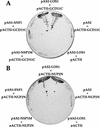Yeast Los1p has properties of an exportin-like nucleocytoplasmic transport factor for tRNA
- PMID: 9774653
- PMCID: PMC109223
- DOI: 10.1128/MCB.18.11.6374
Yeast Los1p has properties of an exportin-like nucleocytoplasmic transport factor for tRNA
Abstract
Saccharomyces cerevisiae Los1p, which is genetically linked to the nuclear pore protein Nsp1p and several tRNA biogenesis factors, was recently grouped into the family of importin/karyopherin-beta-like proteins on the basis of its sequence similarity. In a two-hybrid screen, we identified Nup2p as a nucleoporin interacting with Los1p. Subsequent purification of Los1p from yeast demonstrates its physical association not only with Nup2p but also with Nsp1p. By the use of the Gsp1p-G21V mutant, Los1p was shown to preferentially bind to the GTP-bound form of yeast Ran. Furthermore, overexpression of full-length or N-terminally truncated Los1p was shown to have dominant-negative effects on cell growth and different nuclear export pathways. Finally, Los1p could interact with Gsp1p-GTP, but only in the presence of tRNA, as revealed in an indirect in vitro binding assay. These data confirm the homology between Los1p and the recently identified human exportin for tRNA and reinforce the possibility of a role for Los1p in nuclear export of tRNA in yeast.
Figures






Similar articles
-
Cex1p facilitates Rna1p-mediated dissociation of the Los1p-tRNA-Gsp1p-GTP export complex.Traffic. 2012 Feb;13(2):234-56. doi: 10.1111/j.1600-0854.2011.01304.x. Epub 2011 Nov 15. Traffic. 2012. PMID: 22008473
-
Review: transport of tRNA out of the nucleus-direct channeling to the ribosome?J Struct Biol. 2000 Apr;129(2-3):288-94. doi: 10.1006/jsbi.2000.4226. J Struct Biol. 2000. PMID: 10806079 Review.
-
Nup2p, a yeast nucleoporin, functions in bidirectional transport of importin alpha.Mol Cell Biol. 2000 Nov;20(22):8468-79. doi: 10.1128/MCB.20.22.8468-8479.2000. Mol Cell Biol. 2000. PMID: 11046143 Free PMC article.
-
The small GTPase Gsp1p binds to the repeat domain of the nucleoporin Nsp1p.Biochem J. 1998 Feb 15;330 ( Pt 1)(Pt 1):421-7. doi: 10.1042/bj3300421. Biochem J. 1998. PMID: 9461539 Free PMC article.
-
Molecular mechanisms of nuclear protein transport.Crit Rev Eukaryot Gene Expr. 1997;7(1-2):61-72. doi: 10.1615/critreveukargeneexpr.v7.i1-2.40. Crit Rev Eukaryot Gene Expr. 1997. PMID: 9034715 Review.
Cited by
-
RNA Export through the NPC in Eukaryotes.Genes (Basel). 2015 Mar 20;6(1):124-49. doi: 10.3390/genes6010124. Genes (Basel). 2015. PMID: 25802992 Free PMC article. Review.
-
Yeast nuclear envelope subdomains with distinct abilities to resist membrane expansion.Mol Biol Cell. 2006 Apr;17(4):1768-78. doi: 10.1091/mbc.e05-09-0839. Epub 2006 Feb 8. Mol Biol Cell. 2006. PMID: 16467382 Free PMC article.
-
Steady-state nuclear localization of exportin-t involves RanGTP binding and two distinct nuclear pore complex interaction domains.Mol Cell Biol. 2002 Aug;22(16):5708-20. doi: 10.1128/MCB.22.16.5708-5720.2002. Mol Cell Biol. 2002. PMID: 12138183 Free PMC article.
-
Cloning and characterization of the Schizosaccharomyces pombe tRNA:pseudouridine synthase Pus1p.Nucleic Acids Res. 2000 Dec 1;28(23):4604-10. doi: 10.1093/nar/28.23.4604. Nucleic Acids Res. 2000. PMID: 11095668 Free PMC article.
-
Reconstitution of nuclear protein export in isolated nuclear envelopes.J Cell Biol. 2002 Sep 2;158(5):849-54. doi: 10.1083/jcb.200201130. Epub 2002 Aug 26. J Cell Biol. 2002. PMID: 12196506 Free PMC article.
References
-
- Aitchison J D, Blobel G, Rout M P. Kap104p: a karyopherin involved in the nuclear transport of messenger RNA binding proteins. Science. 1996;274:624–627. - PubMed
-
- Amberg D C, Goldstein A L, Cole C N. Isolation and characterization of RAT1: an essential gene of Saccharomyces cerevisiae required for the efficient nucleocytoplasmic trafficking of mRNA. Genes Dev. 1992;6:1173–1189. - PubMed
-
- Arts G-J, Fornerod M, Mattaj I W. Identification of a nuclear export receptor for tRNA. Curr Biol. 1998;8:305–314. - PubMed
-
- Bailer, S. Unpublished data.
Publication types
MeSH terms
Substances
LinkOut - more resources
Full Text Sources
Molecular Biology Databases
Miscellaneous
